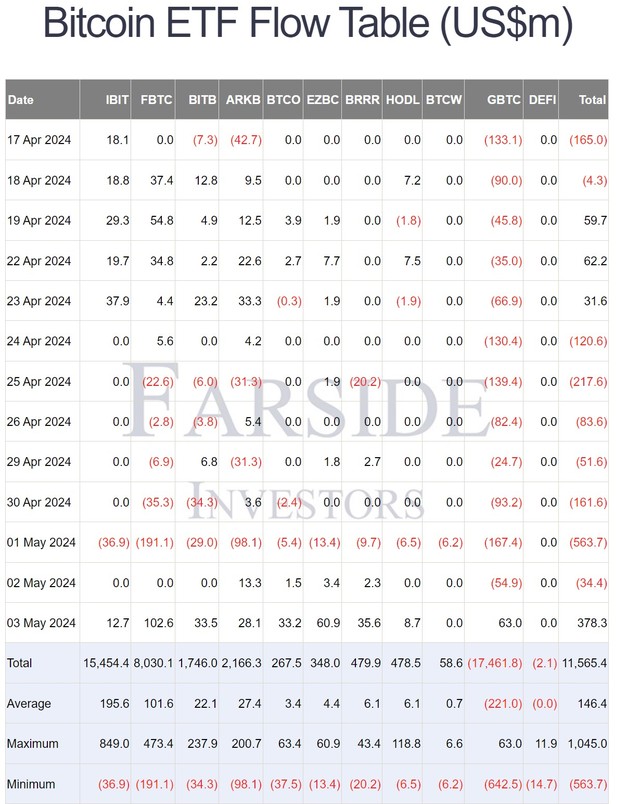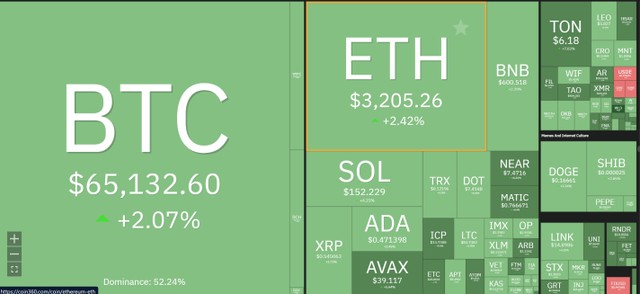Cash flow from ETFs returns: Bitcoin bounces above the $65,000 mark after hitting a 2-month bottom
The fact that Bitcoin has been recognized in a number of countries around the world has made the cryptocurrency market more susceptible to the impact of macroeconomic factors in the world.
Cash flow from IBIT fund ends positive streak
The cryptocurrency market entered the "Sell in May and Go Away" phase quite early when, at the end of April, Bitcoin's streak of 7 consecutive months of growth ended, replaced by an adjustment of about 16%—the worst monthly decline since June 2022 to date.
With a relatively new market like cryptocurrency, there are many factors that can impact and affect the up-and-down trend.
Regarding general developments, it can be seen that the price of the currency representing the Bitcoin market began to decline around mid-March. This time coincided with investors' concerns about the Reserve The US Federal Reserve (Fed) may apply more drastic policy changes in the face of unpredictable inflation in recent months. There have even been many experts who have made assumptions that the Fed may not cut interest rates this year. This sent the DXY index to its highest level since November, and this is typically a bearish signal for risk-on assets such as the stock market and electricity.
Not only that, the complicated inflation context in the US also affects capital flows in spot Bitcoin ETFs. Initial signs of trouble appeared on April 25 when BlackRock's Bitcoin ETF (IBIT) ended a streak of 71 consecutive days of inflows. During this period, IBIT did not see any new cash inflows but total cash outflows amounted to $120 million. Grayscale's GBTC fund also recorded significant outflows, exceeding $130 million. In contrast, Fidelity's FBTC fund attracted $5.6 million and Ark's ARKB fund added $4.2 million in inflows.
May 1 marked the first time that spot Bitcoin ETFs recorded negative cash flows.
By May 2, almost all Bitcoin ETFs recorded capital outflows for the first time, with a total value of up to 563.7 million USD and the largest loss since being licensed. trading began in January. During the brief decline, funds have lost about $6 billion over the past four weeks, representing a 20% decline in assets under management. According to expert observers, at the present time, Bitcoin ETFs are the main driving force driving the market. Therefore, in the short term, small fluctuations from these ETFs will cause the market to be directly affected. In addition, the fact that small investors with unstable psychology are caught up in the selling vortex will also cause the phenomenon of short selling (long squeeze), causing the price of the asset to drop even more sharply.
Behind rain, there is sunshine
However, after hitting the lowest bottom in 2 months (about 56,000 USD), the cryptocurrency market has begun to flourish again. After 7 days of recording a series of continuous cash outflows, on May 3, Bitcoin ETF funds recorded positive cash flows. This is even the first day the GBTC fund has positive cash flow (63 million USD) after 78 days of being in the red. Previously, GBTC recorded capital outflows of up to $17.4 billion, with an average of $224 million per day since converting to a spot Bitcoin ETF. As of the time of writing, Bitcoin price has recovered to above the $65,000 mark.
bitcoin price recovered to the $65,000 mark.
In a report recently published by Coinbase, analysts said that the recent correction not only happened in the cryptocurrency market but also happened in traditional financial markets (end In April, Dow Jones lost 5% of its score, S&P 500 lost 4.2%, and Nasdaq fell 4.4%. In addition, another positive point pointed out by analyst David Han is that Bitcoin's recent correction only had a maximum decrease of 23% from the peak and this is a relatively low correction in the history of the coin. this cryptocurrency.
On the other hand, the trend of the cryptocurrency market following traditional financial markets is predicted by experts to continue because Bitcoin has been legalized and considered a macro asset in Vietnam. some countries, such as the US, Canada, Europe, Australia, etc. Although the cash flow from Bitcoin ETFs in countries outside the US is not high, this can be seen as a signal of participation in the market. Cryptocurrency is the most popular asset management funds in the world.
According to BlackRock, investment funds and large companies are also starting to show signs of participating in the market through Bitcoin ETFs. In the first quarter of 2024, the second-largest bank in Europe, BNP Paribas, made a move to purchase IBIT shares. Financial institutions such as sovereign wealth funds, pension funds and endowments could start investing in Bitcoin ETFs within a few days, said Robert Mitchnick, head of digital assets at BlackRock. next month after learning about the market.






































